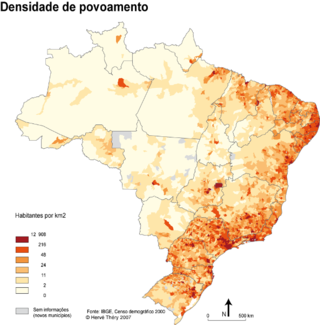Top Qs
Timeline
Chat
Perspective
2000 Brazilian census
Census of Brazil From Wikipedia, the free encyclopedia
Remove ads
The 2000 Brazilian census was the eleventh census conducted in Brazil.[1] It was organized by the Brazilian Institute of Geography and Statistics (IBGE) and took place on 1 August 2000.[2] The Brazilian population rose by 15.43% compared to the previous census in 1991, from 146,917,459 to 169,590,693.[3]
Remove ads
Purpose
Monitoring population characteristics
The census is used to monitor the growth, geographic distribution, and evolution of characteristics of the population over time.[4]
Political representation
The population results of this census were used to determine the number of federal deputies for each state. They were also used to assist in determining the number of state deputies and city councilors.[4]
Resource allocation
The census identified priority areas for investment in terms of health, education, housing, transport, energy, childcare, and old age programs. This information allowed for the examination of resource allocation from the National Health Fund (FNS), the National Education Fund (FNE), and other private and public sources.[4]
Stimulus programs
The census data was used to identify locations that needed stimulus programs for economic growth and social development.[4]
Identify areas of diagnosis
The information gathered by the census was used to identify and bring to the attention of state or municipal governments areas of diagnosis, such as insufficient water and sewage networks, medical care, and schooling.[4]
Remove ads
Population by federal unit and region
Summarize
Perspective

Remove ads
References
Wikiwand - on
Seamless Wikipedia browsing. On steroids.
Remove ads
